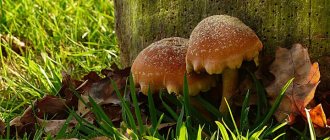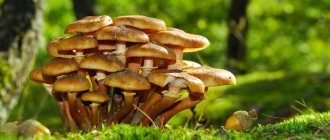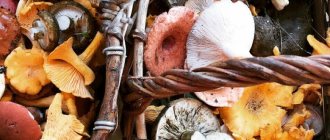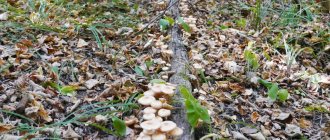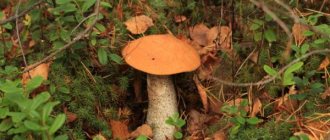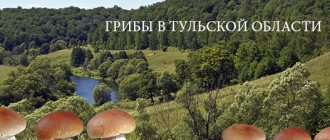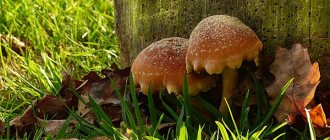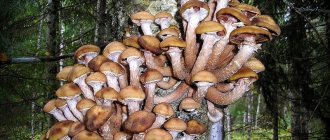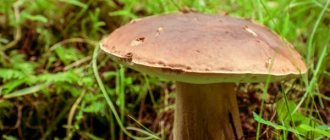Every year, local residents of Tver collect conventional and edible mushrooms for frying, canning and freezing. And 2022 was no exception to the established rules. The collection season began actively in late spring and continues to this day. In the Tver region, mushroom pickers collect mushrooms both in forest areas with deciduous trees or conifers, and in open surroundings: near rivers and lakes, fields, meadows and abandoned summer cottages. Depending on the time of year, you can find not only honey mushrooms and rows germinating in groups, but also noble mushrooms that have no analogues in value, taste and aroma. By going on a quiet hunt in the fall, each guest increases the chances of a successful catch several times due to the peak of the season. A moderate, cool climate, including: rain, warm sun that warms the soil and a cool breeze, contributes to the active germination of each mycelium.
Important!
In any month you should be careful when picking mushrooms. Regardless of its attractive appearance, a forest product may turn out to be inedible at best, and poisonous at worst. When choosing mushroom places on the map, you should take into account the distinctive features of each edible species and its fellows, which contain toxic substances, poisons and carcinogens in their pulp that can cause irreparable damage to human internal organs, causing poisoning, intoxication - and this is in the best case.
Mushrooms in the forests of the Tver region - conditionally and edible
In 2022, in Tver, like any other regions of Russia, the mushroom harvest season begins on the 20th of April and continues until late autumn. It is recommended to conduct searches in favorable weather during the week, when the mushroom rush is reduced due to work routine. Before you go into the forest with a basket, you should read reviews on local forums. There, local residents share their impressions, talking about the forest environment. Finding out whether there are mushrooms in the forest is now quite simple. If photos of harvested crops appear in social networking groups and forums, then a trip to the forest in the next few days will bring maximum benefit.
Benefits and harms
Benefit
The chemical composition of mushrooms is very unique. They are approximately 90% water. They contain fiber, potassium, calcium and magnesium necessary for the construction of cells. A huge amount of vitamins, nicotinic acid and 18 amino acids out of 20 known, taking part in protein synthesis. Regular consumption of mushrooms helps prevent diseases of the liver and kidneys (including urolithiasis), and the circulatory system.
Daily consumption serves as a prevention of malignant tumors and stimulates human immunity.
Harm
Again, due to their chemical composition, mushrooms are considered heavy food that is difficult to digest. People suffering from diseases of the gastrointestinal tract should consume them in limited quantities. They contain chitin, which slows down the functioning of the stomach and, if cooked incorrectly, contributes to putrefactive processes in the gastrointestinal tract.
When preparing dishes, salting or preserving for the winter, it is extremely important to adhere to the exact recipe. You should carefully sort out the crop, wash it in several waters, boil it and then proceed to the main method of preparation. Otherwise, there are known cases of botulism.
TOP 10 edible mushrooms 2022
Today, the most popular types of mushrooms among mushroom pickers are:
- 1st place - morels
These conditionally edible mushrooms can only be collected in spring. Their fruiting occurs in cool, not very hot weather. Deciduous forests, and especially aspen deposits, are considered a favorable zone for their germination.
- 2nd place - lines
Regardless of its conditionally edible variety in Russia and “poisonous” in Europe, many mushroom pickers collect lines in their baskets, hoping for successful heat treatment. Is it worth the risk? It’s difficult to answer... everyone decides for themselves!
- 3rd place - boletus
Porcini mushrooms have always been considered the most valuable fruits of the forest. They can be found not only in forest belts of deciduous trees, but also in coniferous forests. Active growth of boletus mushrooms begins at the end of August and continues until the end of November - beginning of December. Ideal for reproducing first and second courses, freezing and other cooking options.
- 4th place - boletus
Many people mistakenly believe that boletus can only be collected in the fall. In fact, when the weather is favorable, experienced mushroom pickers collect “snotty” mushrooms in spring and summer. In the warm season, competition is reduced, and the chances of success increase several times.
- 5th place - obobki
Boletuses and boletuses received an unusual and bright name of their own a long time ago. And although in the modern world they are called that less and less often, they are popular among mushroom pickers.
- 6th place - chanterelles
For many, the most delicious mushrooms are considered not boletus and honey mushrooms, but saffron milk caps. Their excellent taste, delicate pulp and captivating aroma allow the mushroom picker to prepare both canned food and delicate pates, complex dishes, snacks and holiday salads.
- 7th place - honey mushrooms
The top leaders in the Tver region also included honey mushrooms, which in their germination resemble weeds. You can meet their families in any part of the forest belt, regardless of the air temperature. And in the summer - in fields and meadows.
- 8th place - russula
Only experienced mushroom pickers can collect russula. Due to the similarity with poisonous species, a beginner who decides to pick mushrooms can do more harm to his body than good.
- 9th place - milk mushrooms
The penultimate line is occupied by milk mushrooms due to their main drawback - the duration of heat treatment. Soaking is a simple but time-consuming process and is mandatory in their preparation.
- 10th place - rows
Not only russula, but also rows, are very popular among Tver residents. However, they should only be collected by experienced mushroom pickers who know the distinctive features of each conditional and edible variety.
In addition to the compiled list, in 2022 you can find other edible mushrooms that are popular among lovers of quiet hunting. You can highlight: saffron milk caps, hygrophores, umbrellas, bluelegs.
Mushroom diet
Mushrooms contain a large amount of proteins and carbohydrates in the form of fiber. But the fact is that these proteins are poorly absorbed by humans. Therefore, mushrooms are a low-calorie food. In addition, they take a long time to digest and give a feeling of fullness, which is why nutritionists recommend mushrooms for those suffering from excess weight.
When we walk through the forest, mushroom spores fly into our mouths, but they are not dangerous, since our body simply digests them. Like yeast, about which there is now a lot of controversy - whether they are beneficial or harmful.
“I don’t see any problems with eating yeast at all.” And even if we use them raw, for example, we tried kneaded dough, nothing bad will happen. Yeasts do not live in us. They are also digested in our food system.
Poisonous mushrooms
As we already mentioned above, in the Tver region in 2022 you can find not only noble mushrooms, but also poisonous ones that can harm the body even in minimal dosages. One fruit of the toadstool, accidentally falling into the basket, causes intoxication of the body.
The most dangerous mushrooms are:
- fading and red fly agaric;
- death cap;
- red and yellow-skinned champignons;
- a talker that glows in the dark.
There are other mushrooms that cause poisoning, but they are less common than the five listed. Therefore, in order to maintain your health, you should know all their distinctive features. Knowledge will save you and help you in a difficult situation.
Important!
If the mushroom you find is in doubt, you should not put it in your basket. It’s more correct to pass by, forgetting about the lottery concerning your own life.
Poisonous mushrooms can be not only bright, attracting attention, but also inexpressive, small on a fragile stalk. For example, the red fly agaric is a prime example of what dangerous mushrooms look like with a beautiful appearance. Their large scarlet cap with white spots does not repel, but rather, on the contrary, attracts novice mushroom pickers. The grebe, on the other hand, is not attractive, but often manages to accidentally end up in the baskets of even experienced lovers of quiet hunting. If this happens, upon detection, you should throw away the entire crop, since the potent poison can spread to absolutely harmless mushrooms.
Sexual reproduction
Why do mushrooms need stems and caps? Wise nature came up with this for a reason: for reproduction. The cap contains spores; when they ripen, the mushroom needs to raise the cap as high as possible to help the sowing wind. By the way, this method of reproduction in fungi is called sexual. Unlike most organisms, which are divided into male and female, fungi have about 18 sexes, which combine in different ways. For example, the 3rd can only with the 5th and 7th, etc. So the process of reproduction in mushrooms is very exciting!
The area of the mycelium can reach several square meters; this requires two conditions - the presence of a nutrient medium and moisture. Fungi settle in the soil, in wood, in litter (fallen leaves or needles), etc.
Mushroom places 2022 of Tver and Tver region, photo maps
If you believe the latest reviews left on forums and social networks, the most mushrooms can be found in five places located far from each other. Among them:
Bezhetskoye Highway, located within the district. Many noble species of mushrooms germinate there, as well as honey mushrooms, milk mushrooms and russula. Rows in these vicinities are less common.
Spring and autumn boletus can be found in the village of Mednoye and the village located a little further - Kumordino.
Many mushrooms were spotted in the forest belt near the airport. There they collect species characteristic of both deciduous and coniferous forests. Mixed trees allow almost all myceliums to germinate at certain times of the year, regardless of the season.
No fewer mushrooms are found in the forest bordering the residential buildings of Yunost. And although boletus mushrooms were not seen there, russula, honey mushrooms and row mushrooms were collected by local residents in abundance.
The list of popular places closes with a forest zone running next to the Volga River. You can find mushrooms growing there on the pine forest floor. We are talking about boletus, honey mushrooms, rows and russula.
Contraindications
Mushrooms behave like a natural sponge and are characterized by their ability to accumulate toxins from the soil and environment in their fruiting bodies. They should not be collected near busy roads, burial sites, industrial enterprises and agricultural lands, i.e. where there is either active traffic, or decomposition of organic compounds that are likely to contain toxins, or the use of chemicals. People with weakened immune systems, pregnant and lactating women, as well as children can eat mushrooms only with the permission of a doctor.
Useful tips
- First recommendation
Like many Russian cities, the Tver region does not have environmentally friendly air. This means that in order to collect a lot of mushrooms with health benefits, you should go hunting only in neighborhoods remote from factories, highways, cemeteries and residential buildings.
- Second recommendation
To collect as many mushrooms as possible, you should not only know the places, but also go searching not on weekends, but during the week. On Wednesdays, Thursdays and Fridays, the competition thins out and quite a few people go hunting.
- Third recommendation
If you don’t want to get lost, you should take a navigator (phone with GPS) and a compass with you. They will help you get out of the forest even in difficult situations. The most important thing is to learn how to use a compass and remember to put a point on the map before going deep into the thicket.
Mushrooms in the Tver region in 2022 you can find a lot of mushrooms. However, in order for them to bring maximum benefit, it is necessary to study the distinctive features in advance. They will help distinguish edible fruits from poisonous ones. The knowledge will be useful to both beginners and experienced mushroom pickers in difficult situations.
general characteristics
In order not to spoil the pleasure of harvesting a forest harvest, you should definitely talk to experienced people so that they can tell you where the best mushroom places are located in the region.
Mushrooms are neither plants nor animals, which is why they are often called “forest organisms.” They are divided into 4 categories based on edibility:
- Category 1: edible;
- Category 2: conditionally edible;
- Category 3: inedible;
- Category 4: poisonous.
There is another classification of category 1 based on taste. Edibles are in turn divided into three categories, but according to taste:
- the most delicious and noble: white, white milk mushrooms, saffron milk caps;
- They are somewhat inferior in taste to volushki (white and pink), oak mushrooms, boletus, Polish and forest champignons.
- The category of mushrooms with average taste and weak aroma includes chanterelles, fly mushrooms, honey mushrooms, russula and morels.
Conditionally edible ones are difficult to prepare and do not have a characteristic aroma. These are cobwebs, morel cap, sulfur-yellow tinder fungus, etc. They are cooked for at least 1 hour; this is best done only by specially trained people.
Harvest photo:
Let's hunt correctly
You need to pick mushrooms with a knife in your hand - you cannot tear them out of the ground or twist them, since this actually destroys the mycelium. Not fatal, but consider it a wound. And the more such wounds, the less hope there is for the future harvest. The leg just needs to be carefully cut off at the base. And, of course, you should not take mushrooms near highways and various industrial enterprises: mushrooms, or rather, mycelium, actually accumulate and absorb harmful substances, for example, toxins, heavy metals, radionuclides.
Description of morels
Morels are mushrooms from the genus Morchella (class Pecicomycetes). Most often found in nature is a variety called conical morel. They differ from other types of mushrooms in the cellular-folded structure of the cap.
There are the following types of morels: conical, real (edible or ordinary), cap. There are other types, but they are extremely rare.
Conical morel
Description of the conical morel:
| Options | Signs |
| hat | diameter - from 2 to 4 cm, average height - 4 cm; elongated, cone- or egg-shaped; fuses with the leg, from which it is separated by a rim; hollow; has a mesh structure with cells and ribs; Brown color. |
| Leg | height about 8 cm; thickness - about 3 cm (thicker at the base); cylindrical shape; milky or yellowish; elongated; empty inside; the surface is mealy; fragile. |
| Pulp | creamy shade; waxy; has a weak mushroom aroma and taste. |
| Controversy | creamy shade; in the shape of an ellipse; size: 18 – 20x12 – 14 microns. |
Common morel
Description of the common morel:
| Options | Signs |
| hat | diameter - no more than 5 cm; height - about 5 cm; egg-shaped, round; the edge is fused with the leg; color - yellowish or grayish-brown, brown; cellular structure with partitions. |
| Leg | height - about 7 cm; thickness - up to 3 cm; cylindrical; hollow; milky or grayish-brown tint; smooth or wrinkled; narrow at the top, widens closer to the ground; |
| Pulp | thin; from cream to light brown; tender; fragile; with a delicate aroma and pleasant taste. |
| Controversy | ellipsoidal; dimensions: 18 – 20x10 – 12 microns: light yellow. |
Morel cap
Description of the morel cap:
| Options | Signs |
| hat | height - about 5 cm; width - from 2 to 5 cm; fuses with the leg; longitudinal wrinkles are located on the surface; shade - yellowish-brown or creamy brown; the lower part is smooth, whitish. |
| Leg | dimensions: 6 – 14x1.5 – 2 cm; cylindrical; expands closer to the ground; hollow; whitish yellow; ring-shaped scales on the surface. |
| Pulp | thin; fragile; has a delicate aroma and taste. |
| Controversy | dimensions: 60 – 80x17 – 25 microns; elongated, elliptical in shape; smooth; colorless. |
Tall morels
This variety of morels is difficult to distinguish from the conical one:
| Options | Signs |
| hat | narrow, cone-shaped; height - from 4 to 10 cm; circumference - about 5 cm; the cell on the surface is olive-brown, darkening over time. |
| Leg | cylindrical; the surface is granular; length - from 5 to 15 cm; diameter - 3 or 4 cm; milky in color, darkens with age. |
| Pulp | waxy; light; without distinct taste or aroma. |
| Controversy | Ellipsoidal. |
Important: Many people believe that morel mushrooms are edible, but this is not entirely true. They are classified as conditionally edible, as they contain toxic compounds in small concentrations. They collapse after cooking.
Collection rules
The Tver region is not a place with an exemplary environmental situation. Even edible species collected there can cause poisoning. To prevent this from happening, it is imperative to follow the rules from experienced mushroom pickers.
It is recommended to go out hunting early in the morning, around 5-6 o’clock, and collect only young fruiting bodies. Large, overgrown mushrooms, especially those with an open cap, pose a danger. In old mycelium, the toxins that arise when the mushroom ages and dies become inflamed. Collection cannot be carried out near highways, factories, large landfills, where there is an almost 100% guarantee that all, without exception, even the youngest fruiting bodies are already a reservoir of toxic compounds from the environment.
Collection cannot be carried out during drought. In the absence of moisture in the mycelium, a large amount of poison is immediately formed, which remains in the drying fruiting bodies. The optimal time for “quiet hunting” is 1-2 days after rain. Fruiting bodies grow on average 2-4 days.
Irina Selyutina (Biologist):
Very often, parents take their children with them to the forest to show the beauty of the nature of their native land and convey their experience. Therefore, in such cases it is important:
- Explain the rules for picking mushrooms and why it is forbidden (strictly prohibited) to put your hands to your mouth or rub your eyes. Provide children with disposable paper handkerchiefs for these purposes;
- do not leave them unattended, and especially do not allow them to taste raw mushrooms and berries;
- dress in bright clothes that stand out well against the foliage so that children are always visible;
- do not allow you to leave the field of view (limit this distance to a few meters from yourself).
Mushrooms are collected only with stems. Many poisonous species are recognized precisely by it. It is recommended to photograph the harvested crop in order to identify the cause in case of poisoning.
Symptoms of poisoning
Even edible mushrooms should not be consumed by small children, pregnant women, the elderly and people who have problems with the gastrointestinal tract. They are at risk of adverse reactions.
Poisoning occurs when consuming poisonous or improperly processed conditionally edible mushrooms. Its main symptoms are headache, abdominal pain, nausea, vomiting, and diarrhea. Symptoms appear almost immediately after consumption. In severe cases, loss of orientation, hallucinations, convulsions, and loss of consciousness occur.
The patient must call an ambulance and wash out the stomach and intestines. For these purposes, either clean drinking water or a pale pink solution of potassium permanganate is used in large quantities to induce vomiting. After emergency assistance, a course of medication is prescribed.
A person is especially at risk if, by mistake, the mushrooms collected include toadstool - the “forest killer”, because intoxication processes appear 6-12 hours after accidentally eating it and even after 30 hours.
